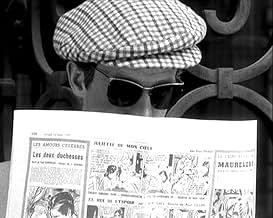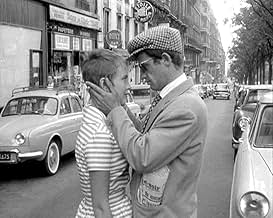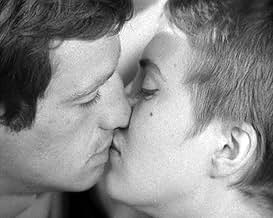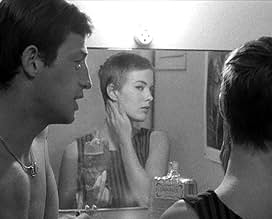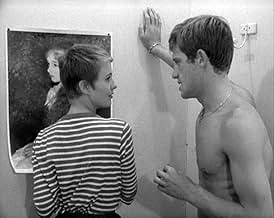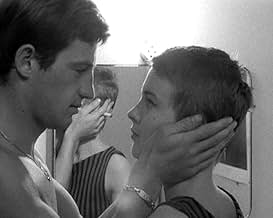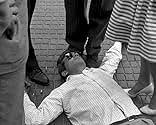Dopo aver rubato un'auto, un ladruncolo uccide d'impulso un poliziotto a bordo di una moto. Ricercato dalle autorità, rincontra una studentessa di giornalismo americana e cerca di persuaderl... Leggi tuttoDopo aver rubato un'auto, un ladruncolo uccide d'impulso un poliziotto a bordo di una moto. Ricercato dalle autorità, rincontra una studentessa di giornalismo americana e cerca di persuaderla a fuggire con lui in Italia.Dopo aver rubato un'auto, un ladruncolo uccide d'impulso un poliziotto a bordo di una moto. Ricercato dalle autorità, rincontra una studentessa di giornalismo americana e cerca di persuaderla a fuggire con lui in Italia.
- Regia
- Sceneggiatura
- Star
- Nominato ai 1 BAFTA Award
- 5 vittorie e 4 candidature totali
- Michel Poiccard a.k.a. Laszlo Kovacs
- (non citato nei titoli originali)
- Patricia Franchini
- (non citato nei titoli originali)
- Tolmatchoff
- (non citato nei titoli originali)
- Police Inspector Vital
- (non citato nei titoli originali)
- Photographer
- (non citato nei titoli originali)
- A Journalist
- (non citato nei titoli originali)
- Man in a White Car
- (non citato nei titoli originali)
- A Drunk
- (non citato nei titoli originali)
- A Journalist
- (non citato nei titoli originali)
- Liliane
- (non citato nei titoli originali)
- …
- Police Inspector #2
- (non citato nei titoli originali)
- The Snitch
- (non citato nei titoli originali)
- Carl Zubart
- (non citato nei titoli originali)
- Antonio Berrutti
- (non citato nei titoli originali)
- A Journalist
- (non citato nei titoli originali)
- Journalist at Orly
- (non citato nei titoli originali)
Recensioni in evidenza
Well, À bout de souffle does not put you under the pressure, it takes you for a ride, and you follow for 90 minutes its incredibly young characters, common crook (Jean-Paul Belmondo) and his American free-spirited girlfriend (Jean Seberg) on their journey on the streets of 1960-th Paris along with Raoul Coutard's legendary camera. I am not going to tell here how great the camera work was, how fantastic the music score and the views of Paris were - the fans of the film know that already. They also know about the beginning of French New Wave, and how it influenced the future cinema. I just want to say that the movie was made over forty years ago - the smoking was cool back then, and Belmondo made smoking look very sexy. Belmondo fascinates me in this film. I've seen him in a lot of later movies - he's always been good (I recommend Le Magnifique, 1973 and Le Professionnel,1981 ) - but in À bout de souffle he is not just good - he is embodiment of cool, his face changes its expression every moment, you can not take your eyes off him. Is it me or he does remind the very young Mick Jagger - not commonly handsome but irresistible and sexy? He and young (she was 21 at the time) Jean Seaborg made one of the best screen couples ever. My favorite scenes:
Michel drives the stolen car in the beginning of the film, and he starts to talk to us, the audience. The day is nice, the sun is shining, and the life is beautiful...
Michel and Patricia drive in the convertible. The wind plays with her short hair. We only see the back of her head and her neck. Michel tells her that he loves the girl with a beautiful neck, wrists, knees, but she is a chicken...
Patricia comes to the hotel to find Michel in her bed. They start talking about nothing and about very serious things. They smoke, she tries to find a good place for her new poster, and he wants to sleep with her. In the end of the scene, his face, he looks at her - there is love in that look...
There is more - I am sure everyone who saw it has his/her favorite scenes.
With his knowledge of classic film narrative and style Godard went out to create his own film in homage to, and also complete contradiction to, classic Hollywood film.
The plot reads almost like a crime thriller typical of the 1930-40's. A criminal on the run from the police; the distraction of a beautiful woman; the escape and eventually someones death. But it is in Godard's approach to film style and use of new technologies that the typical crime thriller was turned on its head.
In a break from classic Hollywood narrative the film opens with little equilibrium. Our protagonist's motives are unclear as he tears off to Paris leaving a woman and a dead cop in his trail. This in turn makes the ending somewhat open ended. With no sense of equilibrium to start with how can there be closure on what has happened throughout the film.
Another twist on the classic storytelling in film is the progression of plot. It is naturally assumed in classic Hollywood film, that everything the spectator sees they see for a reason. With Michel's constantly pointless phone calls to retrieve owed money the plot is not pushed along at all. The inclusion of a 25 minute digression from the plot stands to emphasise the spectators reliance on narrative structure in the watching of films. Although watching the film closely is, as always, important in following the story A Bout de Souffle requires that little bit extra to define where the plot is being progressed and where Michel or Patricia are just flattering their egos or each other.
All in all I personally think that A Bout de Souffle brought about a sense of realism not seen in Hollywood cinema before 1959 and even now. The fact that life isn't full of clues that will help us progress in say our relationships or escape from authority, but is infact full of digression; self exploration; and the confusions of love, ego and aspirations.
Ironically, the pace of this movie isn't "breathless" at all. It begins abruptly and takes a while to get going: Michel (Jean-Paul Belmondo), a character we barely know, drives a stolen car around, talks at the camera, and shoots a police officer who has tried to pull him over. Then he goes to Paris and tries to borrow money from some friends, while the police-shooting plot goes undeveloped. I only became fully engaged with the introduction of Patricia (Jean Seberg), a young American who sells newspapers on the Champs-Elysees. The relationship between Michel and Patricia is the heart of the film, especially a 25-minute-long scene in Patricia's apartment where the characters smoke, flirt, and laze around in bed, though nothing really happens. That's where I really started to admire "Breathless," because I was so captivated by a scene that, on paper, doesn't sound all that captivating.
Eventually the police catch onto Michel and launch a manhunt, but this doesn't really ratchet up the suspense. Instead, Michel is (or at least, Michel acts) aimless and nonchalant about the whole thingthis is not a typical "man on the run" movie. The cool jazz score adds to the hip, laid-back tone.
Since I didn't care for the movie too much until the scenes between Michel and Patricia, I believe a lot of the credit for the film's success has to go to the charismatic performances of Belmondo and Seberg. Belmondo, with a perpetual cigarette dangling from the corner of his mouth, is the archetypal cocky criminal who models himself after Humphrey Bogart (there's a great scene where he sees some Bogart photos and gets a vulnerable look in his eyes, as though saying "I'll never be as cool as this"). Seberg plays Patricia as a confused girl who is delighted by the attention she gets as an American in France.
It's easy to see why "Breathless" was so influentialthe jump cuts, the ragged style perfectly match this story about amoral, aimless youth. Definitely a movie that expanded the range of stories the cinema can tell, and perhaps a major precursor to youth-oriented '60s culture. Nearly fifty years later, it still seems "hip," and still challenges our expectations of how movies should behave.
Lo sapevi?
- QuizDespite reports to the contrary, Jean-Luc Godard did not shoot the film without a script; however, he did not have a finished script at the beginning, instead writing scenes in the morning and filming them that day. See also Il bandito delle 11 (1965).
- BlooperDuring street shots, countless passersby look at Patricia and Michel and stare into the camera, revealing that the shots were made without filming barriers and simply used street pedestrians in place of extras.
- Citazioni
Patricia Franchini: What is your greatest ambition in life?
Parvulesco: To become immortal... and then die.
- ConnessioniEdited into Pariz pripada nama! (2016)
I più visti
Dettagli
- Data di uscita
- Paese di origine
- Lingue
- Celebre anche come
- Sin aliento
- Luoghi delle riprese
- 11 rue Campagne Première, Paris 14, Parigi, Francia(on location)
- Aziende produttrici
- Vedi altri crediti dell’azienda su IMDbPro
Botteghino
- Budget
- 400.000 FRF (previsto)
- Lordo Stati Uniti e Canada
- 414.173 USD
- Fine settimana di apertura Stati Uniti e Canada
- 32.424 USD
- 30 mag 2010
- Lordo in tutto il mondo
- 596.100 USD
- Tempo di esecuzione1 ora 30 minuti
- Colore
- Mix di suoni
- Proporzioni
- 1.37 : 1
Contribuisci a questa pagina






